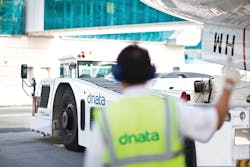Airside GSE Puts dnata’s Equipment Through A “Thorough Examination”
Throughout much of the UK, car owners have to put their vehicles through an annual so-called "MOT test" once the cars are more than three years old. The Ministry of Transport test looks at safety, roadworthiness and emissions testing.
There are similar regulations on the books covering ground support equipment that require GSE to pass a so-called “report of thorough examination.”
“The law for GSE is even more demanding,” says Mike Cardy, managing director, Airside GSE Ltd, which has offices close to TAG London Farnborough Airport in Hampshire with a workshop about five miles from the airport in Hook. “The examination is required as soon as the equipment is a year old – and may be needed once, twice or even four times a year, depending on the equipment and its use.”
Cardy’s company was set up specifically to conduct such tests on GSE. One of Airside’s first clients is international ground handler dnata for its GSE fleet operating in the UK, primarily operating from London Heathrow Airport.
John Edmunds, business manager for dnata has initiated the procedure to ensure that the ground handling service provider’s equipment not only meets, but exceeds the current requirements to have equipment thoroughly examined at least every 12 months and in the cases where equipment is used to elevate and transport passengers and personnel, at least every six months.
“Specifically, if a thorough examination is carried out on an aircraft elevator/loader we would envisage that the inspection would take between 1 hour to 90 minutes,” Cardy says. “The exam requires that the lifiting parts of the machine are inspected under a regulation referred to as LOLER for “lifting operation and lifting equipment regulations” and the motive power, in other words, the engine, hydraulics and steerting, are examined under the PUWER regulation for “power and use of work equipment regulations.”
Cardy knows a thing or two about such regulations since he worked on the CEN (European Committee for Standardization) that was responsible for compiling and publishing some 20 legal standards that regulate the building, designing and testing of all GSE.
NOT AVERAGE MAINTENANCE
Working closely with dnata’s operational requirements, Airside staff of seven work under what Cardy calls a “quality assurance procedural code.” The company’s also developed dedicated documentation to support the thorough examination process.
“Not every inspection is a ‘thorough exam,’ ” Cardy adds, “and it’s important to know the difference.”
Inspection is part of any routine service and maintenance – the emphasis is more on function. Upon completion of a thorough examination, however, the examiner will provide documentation that everything has been carried according to the strict standards demanded by the law. The documention includes the following:
- A report in accordance with LOLER.
- A checklist showing what has been checked and any comments made.
- A certificate to keep with the equipment.
- A sticker placed on the equipment that shows the due date for the next thorough examination.
